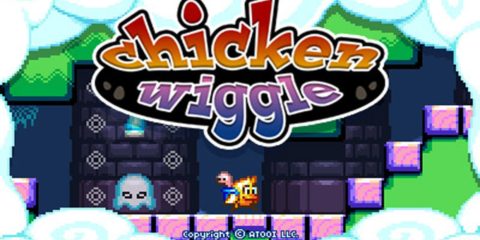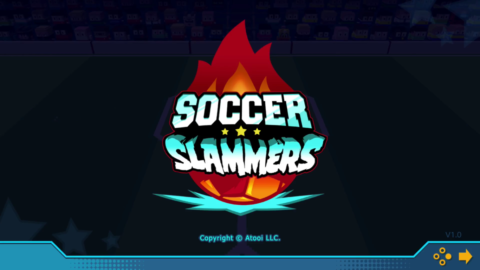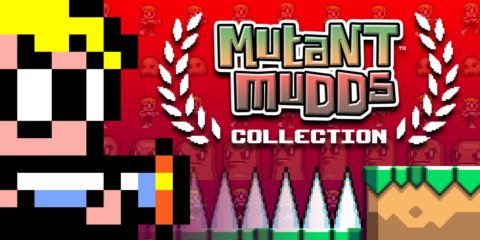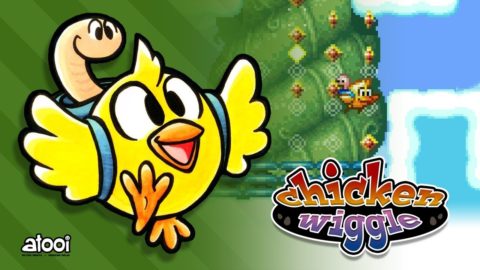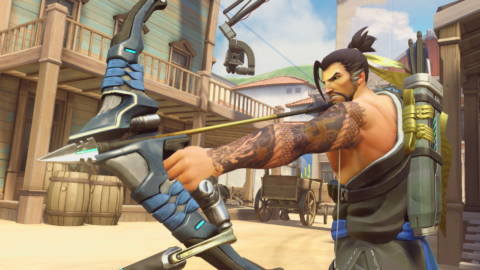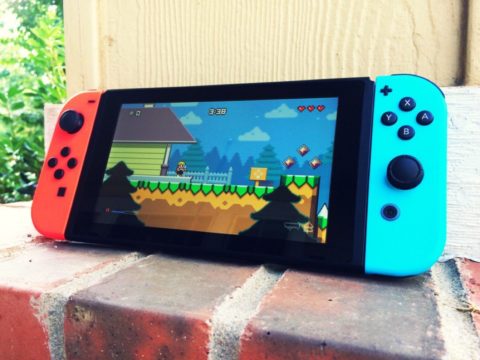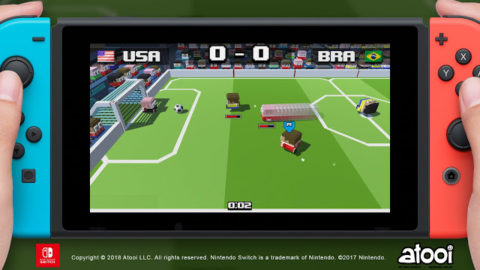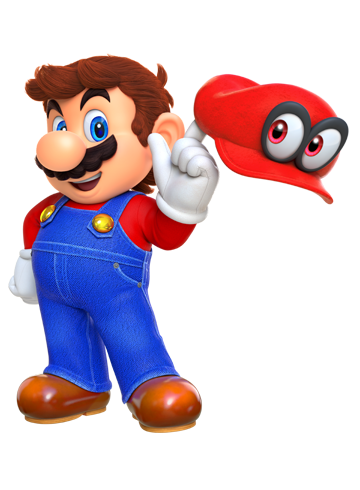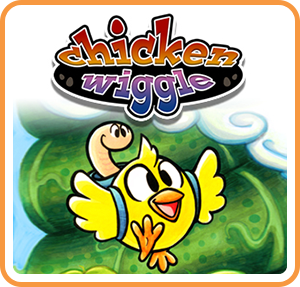
If there’s one thing to say about the Nintendo 3DS throughout its lifetime, its that the handheld system has always made a great home for classic and modern 2D platformers. It’s a genre that Nintendo knows well, and one that developers often look to for a blend of eye-catching design and simple (yet demanding) gameplay concepts.
Chicken Wiggle, the latest from veteran 3DS developer Atooli, is a satisfying blend of 16-bit look and modern feel that’s right at home in the 3DS’s family of 2D platformers. It’s a game that feels very aware of what it is: simple and welcoming, with enough charm to draw you in and plenty of features to keep you coming back.
Chicken Run
The premise is simple enough; an evil witch has captured all of the feathered villagers of an unnamed town and imprisoned them. The titular Chicken has avoided capture and now must rescue his friends with the help of his newfound worm friend, Wiggle. (Oh, and Wiggle sits in Chicken’s backpack, not his mouth or anything. That would just be weird.)

While it doesn’t exactly take storytelling in bold new directions, the setup is solid enough to put you in control of the dynamic Banjo Kazooie-esque duo. Wiggle helps Chicken navigate the witch’s evil sky towers by whipping forward to grab walls, ceilings, and obstacles, pulling Chicken along. It’s an effective movement tool; you can chain these whip motions together to quickly navigate hazards and sometimes save yourself from death.
Chicken can also peck with his beak, which serves as your primary method of attack. This links up nicely with Wiggle’s whip mechanic, allowing you to stun moving enemies to line up an easy shot. While the movement and combat mechanics are tight, combat can often feel like it was included almost on principle. Enemies feel like a minimal threat, and more often than not it’s a waiting game until they’re in position to strike rather than an honest struggle against a dangerous foe.
Adding to standard movement and combat are special pieces of equipment that give Chicken unique abilities. The levels in which these appear are pretty closely aligned with the abilities they offer; a construction helmet lets you blast through walls you otherwise couldn’t, and a hero mask lets you float above danger. These abilities add some welcome diversity, but they speak to a lack of depth in the overall game. The option select from abilities you gain feels like it would add to the experience, but many levels would be too easy or downright impossible without a particular piece. Overall, the abilities are fun and often clever, but they begin to feel a bit arbitrary after the first few rounds.
The stages themselves feel very carefully crafted. There are moments of real exhilaration, as you chain Wiggle’s whips between narrow rows of spikes or across platforms that shift or disappear as you jump. These are balanced nicely with moments of careful observation; some enemies time with your movements or jumps as well, forcing you to plan your run through a dicey gauntlet or face the sting of trying all over again. It’s the kind of level design that speaks to the speed-runner in some of us, as it’s possible to build up a rhythm that will carry you daunting sections in the blink of an eye.
All of that precision does come with a price. There are moments tied to the game’s core movement that feel a bit out of place. Often I found myself expecting Chicken to fall, as he’s, well…not holding onto anything. It’s in these moments where the game allows you to sit in a single square, patiently picking your direction and striking without any fear of plummeting to spikes or an enemy below. It’s an odd choice that’s clearly necessary for many of the puzzles to operate, but one that almost feels like a design error that was simply worked into the end result. While it doesn’t harm the overall experience significantly, it forces the player out of the moment early on, making you question what the developer was trying to do.
Filling your pack
Reaching the end of the level isn’t your only goal in Chicken Wiggle. While you race to rescue your friends, there are collectibles littering the sky towers that help you stay on track, or you to explore beyond.
Each level has 100 gems that you’ll collect as you go. There’s no particular order to collect them in, and you’ll sometimes have to backtrack a little to collect them all. These gems serve a higher purpose though, often leading you through the level and subtly hinting at optimal paths through danger. Occasionally, they’ll even lead you to the game’s other collectible as well.
Three “F-U-N” tokens are strategically hidden in each level, in addition to the numerous gems. You’ll often find the first of the three with little difficulty, but the others may require some careful navigation to grab. It’s clear these were designed to be pretty difficult to find. As I said, gems will sometimes hint toward or downright lead to a token, but often you’ll find yourself testing walls for secret passages, or combing back through a level to find tokens that are pretty far off the beaten path.
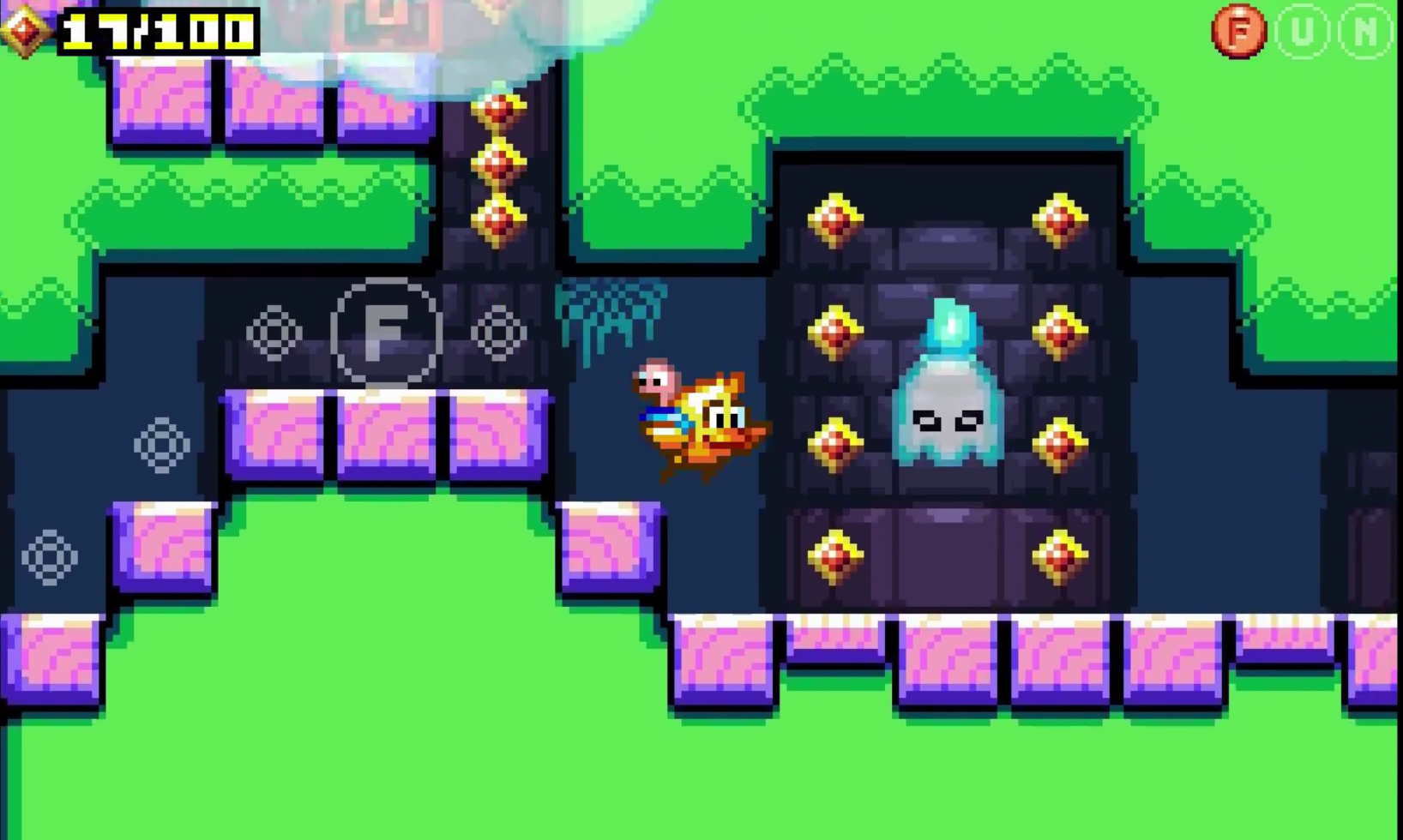
It’s clear the collectibles are a crucial part of the experience here, both as a navigation tool and a welcome break from your core goals. It speaks to familiar “side quest” options in classic platformers but sadly doesn’t seem to be much more than that. Neither the coins or tokens serve any benefit to our heroes as they move through the sky towers. The game doesn’t count lives or offer power-ups, so there’s little at stake and little incentive to collect beyond collection’s sake itself. Completionists will get some replay value out of grabbing everything, but others may quickly lose the thrill of filling Chicken’s backpack with loot.
If you build it, they will jump
Chicken Wiggle offers a fairly short core campaign, all things considered. Ten towers of six levels each are enough to occupy a short time, but once we’ve bashed all the baddies and grabbed every gem there’s not much to retread there. Luckily, Atooli has added a pretty robust playground for players that want more feathery antics.
A full suite of level creation tools is available for players to build their own Chicken Wiggle levels. Every environment, obstacle, enemy, and collectible in the game can be found here, and creators have free reign to stack them any way they please. I found the tools delightfully easy to use for how many options are available, and it’s certainly the kind of extra feature that has potential to consume more time than the core campaign itself.
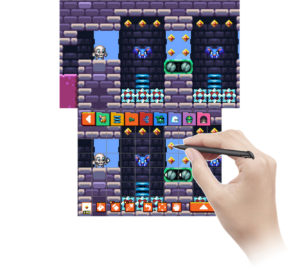
The 3DS’s bottom screen is a powerful tool here, allowing creators to sketch out a level’s path within the environment or fill the entire space and tunnel through, adding obstacles and features as they go. The full space you’re able to fill is actually quite vast, so levels can be as simple or maddeningly complex as you want them to be.
Chief among the options available is the ability to create levels with different goals than the campaign’s “operation chicken rescue” directive. Creators can put players through coin-collecting or baddie-bashing gauntlet, and in a surprising twist, guide a skeleton baddie to his headstone home. All of the tools are there to really ramp up the challenge from the main quest, and it’s a welcome change for those who want a little more.
What good is crafting a masterpiece of side-scrolling mayhem if you can’t share it with the world? Chicken Wiggle lets you post your created levels to a database for other players to download, play, and rate. It’s very reminiscent of Mario Maker‘s success in this space, letting players create content and drive the continued success of the community.
For a game like Chicken Wiggle, though, it almost feels like the level creator is what you’ve really come for. It provides a lasting experience that the core campaign leaves out, and one that’s significantly more robust than that campaign as well. While it’s certainly worth congratulating Atooli on making that experience available, it does further highlight where the single player story could have gone.
The bottom line
Chicken Wiggle is fun, adorable, and very much a product of its roots in the 16-bit, cartoony age of run and jump side scrollers. The art and environments are precise and engaging, and the modular design carries over nicely to the level creation tools, making even the simplest creations feel like something organic and believable. The music is at once charming and atmospheric; a chiptune soundtrack worthy of the genre and clearly crafted with a good deal of care.
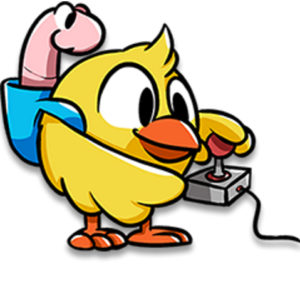 The gameplay is accessible and satisfying to master, and the diversity of the level design in the main campaign should keep players on their toes to the very top of the last sky tower. It’s not without its faults, and I can’t help but wonder if a bit more ambition in fleshing out the mechanics would have really brought the single player experience to life. Still, there’s something here for all ages and skill levels, and it’s worth seeing through to the end.
The gameplay is accessible and satisfying to master, and the diversity of the level design in the main campaign should keep players on their toes to the very top of the last sky tower. It’s not without its faults, and I can’t help but wonder if a bit more ambition in fleshing out the mechanics would have really brought the single player experience to life. Still, there’s something here for all ages and skill levels, and it’s worth seeing through to the end.
The star of the show is by far the game’s level creation suite and the potential for players to build the world out beyond the main storyline. With tools that are simple to master and offer a wide range of gameplay features, it’s easy to see players spending hours crafting challenges and testing their skills. The sharing functions are easy to pickup and the whole system for uploading, downloading and playing levels works smoothly and is easy to navigate.
If you’re looking to expand the collection of retro-inspired platformers filling the storage blocks on your 3DS, Chicken Wiggle is worth the price of admission. It’s worth checking back on again and again, too, for new user-created levels to challenge bird and worm both.
Chicken Wiggle will be available for Nintendo 3DS on August 17th for $14.99.
